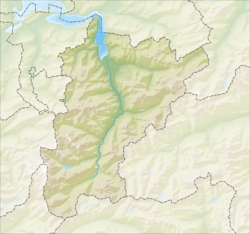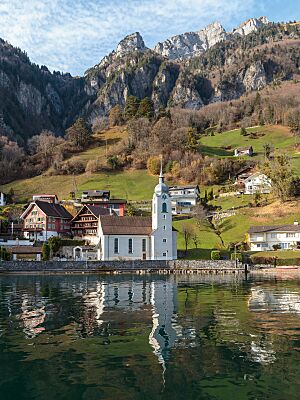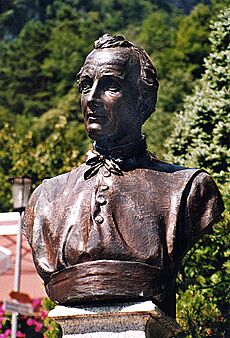Bauen facts for kids
Quick facts for kids
Bauen
|
||
|---|---|---|
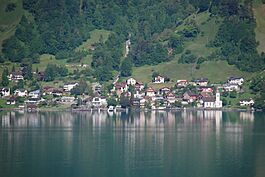 |
||
|
||
| Country | Switzerland | |
| Canton | Uri | |
| District | n.a. | |
| Area | ||
| • Total | 3.77 km2 (1.46 sq mi) | |
| Elevation | 436 m (1,430 ft) | |
| Population
(December 2019)
|
||
| • Total | 165 | |
| • Density | 43.77/km2 (113.4/sq mi) | |
| Postal code |
6466
|
|
| Surrounded by | Flüelen, Isenthal, Seelisberg, Sisikon | |
Bauen was once a small town, called a municipality, in Switzerland. It is located right on the beautiful Lake Lucerne. Bauen was part of the canton of Uri.
On January 1, 2021, Bauen joined with another town called Seedorf. This means Bauen is no longer its own separate municipality.
Contents
History of Bauen
Bauen was first mentioned in old records way back in 1150. It was known as Bawen then.
Joining Seedorf
The towns of Seedorf and Bauen were the first in their canton to decide to merge. This happened after a new rule allowed towns to join together. They planned for the merger to happen on January 1, 2021.
Before the merger, people in both towns had to vote. This vote, called a referendum, happened in October 2019. Most people in both Seedorf (80%) and Bauen (69%) voted yes. So, the towns officially merged on January 1, 2021.
Geography of Bauen
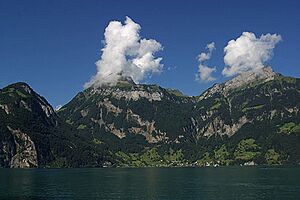
Bauen covers an area of about 3.8 square kilometers (about 1.5 square miles). A good part of this land, about 13.5%, is used for farming. A much larger part, about 74.9%, is covered by forests.
About 2.9% of the land has buildings or roads. The rest, about 8.7%, is natural land like rivers or mountains.
Location and Climate
The village of Bauen is on the west side of the Urner lake. This lake is part of the larger Vierwaldstättersee, also known as the Lake of the Four Forest Cantons.
Until 1956, it was hard to get to Bauen. The only ways were steep walking paths from nearby towns. Because it's by the lake and gets a special wind called Föhn, Bauen has a very mild climate.
People of Bauen (Demographics)
In 2019, Bauen had a population of 165 people. About 8.7% of the people living there were from other countries in 2007. Over the last 10 years, the number of people living in Bauen has gone down by about 14.1%.
Most people in Bauen speak German (99.1%). A few people speak Italian (0.4%) or Czech (0.4%). In 2007, about 48.7% of the people were male and 51.3% were female.
Education and Jobs
Many adults in Bauen (about 75.6% of those aged 25–64) have finished high school or gone on to higher education. This could be a university or a special college called a Fachhochschule.
Bauen has a very low unemployment rate, about 0.76%. This means almost everyone who wants a job has one.
In 2005, 16 people worked in the primary economic sector, which includes farming. There were 8 businesses in this area. Seven people worked in the secondary sector, like manufacturing, with 3 businesses. The largest group, 44 people, worked in the tertiary sector, which includes services, with 7 businesses.
Population Changes Over Time
Here's how the population of Bauen has changed over many years:
| year | population |
|---|---|
| 1799 | 115 |
| 1850 | 175 |
| 1900 | 167 |
| 1950 | 194 |
| 1970 | 157 |
| 2000 | 228 |
| 2005 | 192 |
| 2014 | 176 |
Coat of Arms
Bauen's flag or coat of arms was first mentioned in 1849. It shows golden elk horns with ten red flames on the tips. There's also a bigger red flame above the elk's head. All of this is on a black background.
Meaning of the Coat of Arms
The idea for this coat of arms came about in 1843. It was inspired by St. Idda von Fischingen. Her church choir used a symbol of an elk with flaming horns. This symbol dates back to around 1812, when the church was first opened. The oldest coat of arms that is still in good condition can be seen in Bauen's old guardhouse.
Famous People from Bauen
Alberich Zwyssig was born in Bauen. He was a composer who wrote the music for the Swiss psalm "Trittst im Morgenrot daher." This is a very important song in Switzerland. You can see a statue of him in front of the village church.
See also
 In Spanish: Bauen para niños
In Spanish: Bauen para niños




